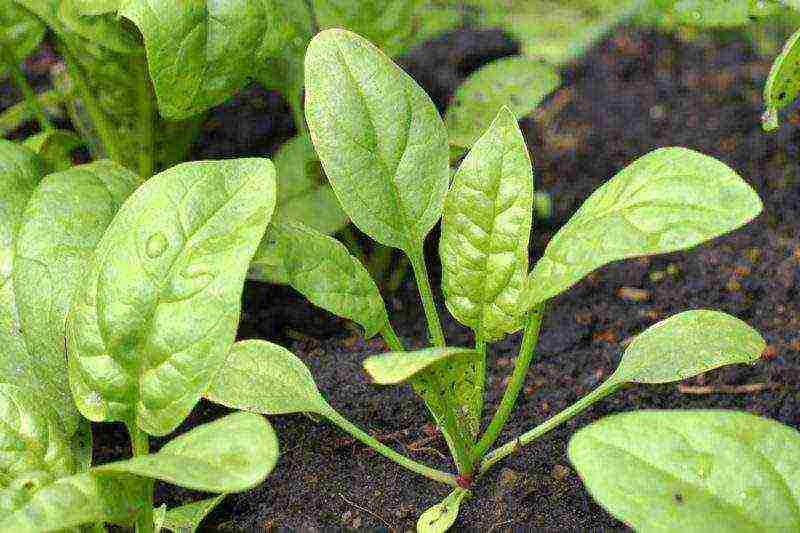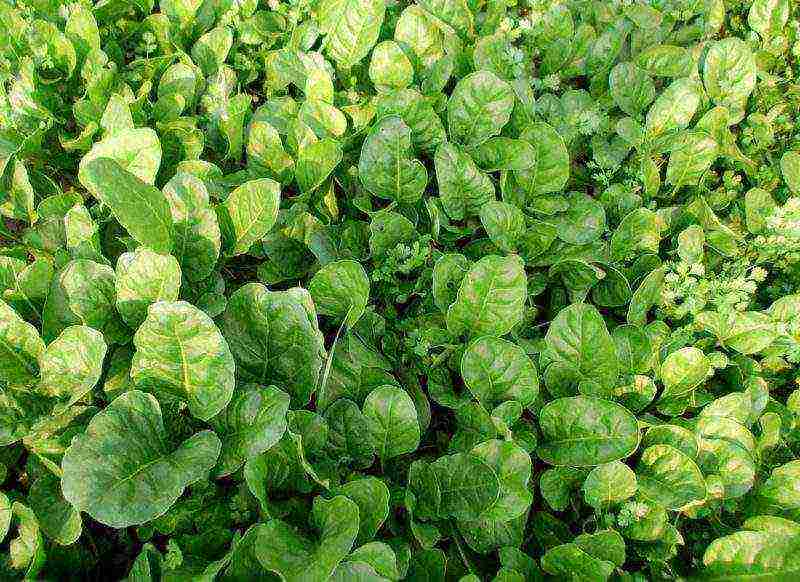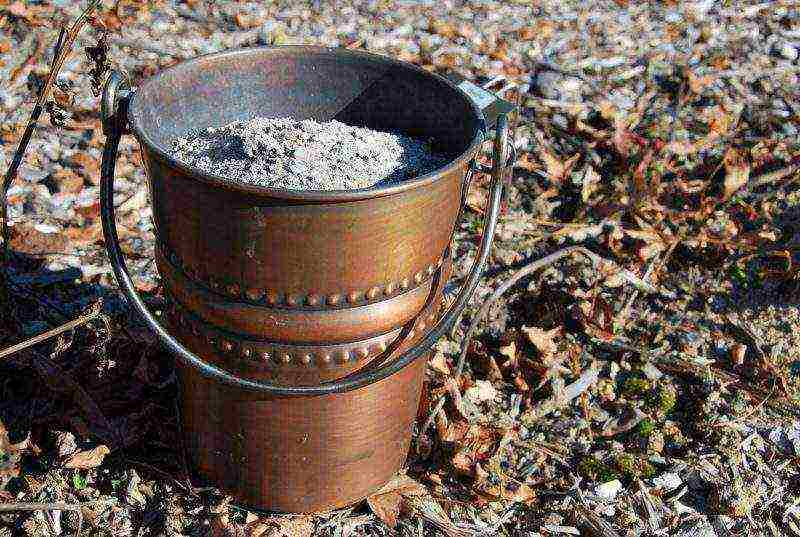Content
- 1 The originality of green culture
- 2 Qualitative characteristics of vegetable crops
- 3 Varietal diversity of culture
- 4 Choosing a landing site
- 5 Features of soil preparation for sowing greenery
- 6 Cultivation methods
- 7 Preliminary preparation of seeds
- 8 How to sow a crop correctly?
- 9 The specifics of growing greenery in a greenhouse and at home
- 10 Green crop care technology
- 11 Harvesting vegetable plant
- 12 Growing spinach in the garden: basic requirements
- 13 When to start planting spinach and how to do it right?
- 14 Features of growing strawberry spinach
- 15 Spinach care: from planting to harvest
- 16 Tips to know when growing spinach from seeds
- 17 What plants in the neighborhood will spinach get along well with
- 18 Which pests and what diseases can threaten spinach
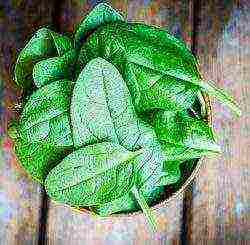 In open ground, many summer residents practice planting garden spinach due to the fact that it is very useful and not picky about care. This green crop is an annual, so all its varieties can only be grown from seeds.
In open ground, many summer residents practice planting garden spinach due to the fact that it is very useful and not picky about care. This green crop is an annual, so all its varieties can only be grown from seeds.
Description: varieties and varieties of spinach
Inexperienced summer residents sometimes even in the photo confuse spinach with sorrel, although these plants are not at all from the same family. Those who are engaged in the cultivation of different varieties of both crops know the difference perfectly. Spinach leaves are rounder and richer in color, and its taste, in contrast to sour oxalic, is delicate and piquant. This annual (less often - biennial) belongs to the family of haze and is listed as a relative of beets and chard.
There are many varieties of garden spinach. Most often, the following are grown in the country:
- Gigantic;
- Matador;
- Fatty;
- Victoria and others.
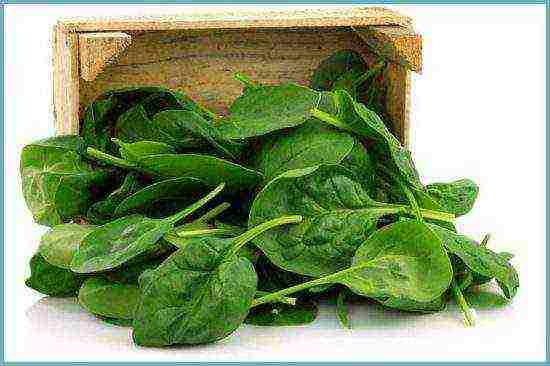
Spinach leaves
They differ in appearance and ripening times. In general, spinach is early ripening, so you can sow it on a conveyor belt every 3-4 weeks.
Planting plants in open ground
Experienced summer residents are advised to plant spinach in the fall. Before the onset of cold weather, he manages to release small outlets. Although sowing in open ground is also possible at the end of April, when the soil warms up a little. The depth of the beds should be about 2 cm. The distance between seeds is 6-8 cm. The gap between adjacent rows is 0.2-0.3 m.
After planting in open ground, you need to slightly crush the earth, water it and cover it with burlap - not for long, for 3-4 days. Above the beds, you need to install a frame. Its height is 0.2 m. The entire structure should be covered with foil. Spinach is considered a cold-resistant crop, therefore, at t + 2 ... + 5 oC, its seedlings will hatch in 1.5-2 weeks.
Advice. Spinach planted before winter is shot less frequently and yields an earlier harvest.
Care and harvest
Thin out the emerging seedlings immediately. Please note: there should already be 2 real leaves on the sprouts. The optimal distance between plants is 7-10 cm. This care measure will be a good prevention of some diseases and pests. In the future, repeat it with grown specimens. Remove those with few leaves.
Water the plants after thinning. There should be enough moisture in the beds. Drying out of the soil is fraught with shooting and spinach flowering. This impairs the taste of the healthy leaves. However, over-irrigation when growing green crops is also bad. Usually, in dry weather, the beds are watered 3 times a week using a bucket of water for 1 square meter. m landings.

Young spinach leaves
Do not forget about other rules of care: regularly loosen the soil and remove weeds.When 5-6 adult leaves appear on the plants, start harvesting. Waiting for too much greenery to appear is impractical. The more "mature" the plant is, the less tasty and healthy it is. With proper care, spinach does not create problems and produces a good harvest.
Fertilizing and feeding spinach
Green culture does not like fresh organic fertilizers. After harvesting, add mineral fertilizing to the soil: per 1 sq. m will need 30 g of superphosphate and 2 times less potassium chloride. If you are not planning a winter planting of spinach, then in the spring add 20 g of urea per 1 sq. m of soil.
Further care consists in the use of nitrogen fertilizers. Do not use them all the time, but only if the plants develop poorly. Combine top dressing with watering.
Attention! Phosphate fertilizers will speed up the flowering of spinach, so avoid them.
Plant propagation: collecting and preparing seeds
You can harvest seeds yourself from spinach planted outdoors. They are used for breeding in the coming autumn or next spring. Since spinach is a dioecious crop, i.e. has specimens with female and male flowers, for "procreation" you need to find plants of the first type. Even after looking at the photo, you will notice that they are larger, retain their appearance longer, and there are more leaves in their rosettes.
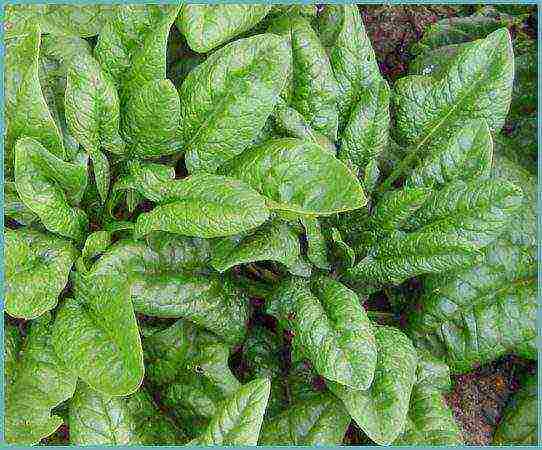
Monitor the health of your spinach in your garden
The collection can be started after about 3 months. after sowing spinach. The foliage of a plant that is ready to give planting material for propagation turns yellow, and the seeds themselves turn brown. It is important that the spinach is not shot. The testes are cut in the morning: this way they crumble less. They are dried for 2 weeks in a ventilated area.
The seeds are suitable for reproduction for 4 years. Before planting, they are soaked for 48 hours. The water should be warm, about + 25C. It is changed every 6-8 hours. After that, the seed is dried and sown.
Advice. Varieties growing nearby are pollinated. To prevent this from happening, sow them at different times. Flowering usually begins 42-53 days after sprouting.
Diseases and pests of spinach
If you notice yellow spots and a dirty coating on the leaves, this is downy mildew. Sick plants need to be removed, this will stop the reproduction of the disease. To prevent the onset of disease, provide the correct care for the green culture:
- Thin seedlings.
- Do not get carried away with watering, as high humidity is a condition for the development of downy mildew.
- Re-plant all spinach varieties after 3 years at the earliest.
To prevent root rot, regularly loosen the soil and control watering, otherwise this disease will thin the roots and destroy the plant. If you do not pull up weeds or forget to thin out the beds, be prepared for an invasion of scoop caterpillars. They can be collected by hand. To kill aphids, prepare a tincture of tobacco. Purchase an insecticide, dig up the soil, and avoid planting beets next to spinach to control miner flies.
Combination with other plants on the site
In the open field, you can make separate beds with spinach, or you can cultivate this crop in the aisles. In the second case, it is good to use joint plantings with potatoes, eggplants, tomatoes, beans or peas. A combination with corn, grapes, cauliflower and white cabbage will be productive. Onions, celery and garden strawberry bushes can also be planted next to green crops.
In Germany, a combination of spinach with many plants is popular. The Germans are sure that this representative of the Haze family has a positive effect on the growth of other crops, retains the moisture and looseness of the soil. It is believed that spinach is friendly with absolutely all vegetables. But if you want to play it safe, keep healthy annuals away not only from beet planting, but also from asparagus and zucchini.
Growing spinach: video
Spinach: photo
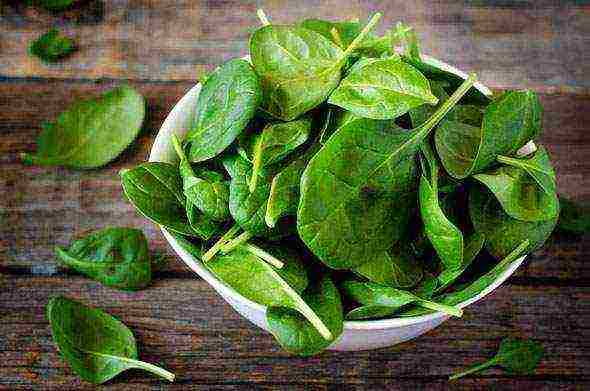
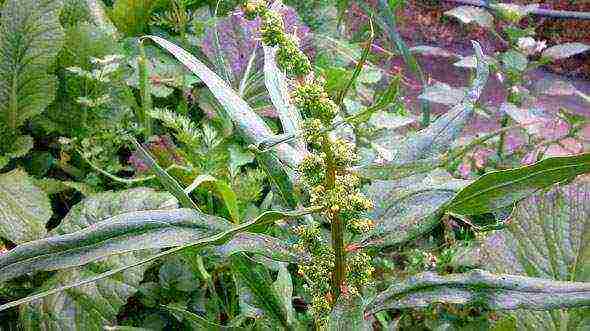

Spinach is a herbaceous vegetable that is popular and loved all over the world. The French, for example, consider this culture of ancient origin to be the king of vegetables. How to grow spinach in a country house of good quality - this question is of interest to many summer residents.
The originality of green culture
Spinach is a rosette of glossy leaves. This is a heterosexual plant. There are male and female representatives of the vegetable. In male specimens, small and few leaves emerge from the sinuses. They are removed during thinning. Large, juicy leaves for cutting are given by females, they are left in the beds. Female specimens form nut seeds.
Spinach roots are weak, growing 20 cm deep, which complicates the process of growing and care.
The culture is also called a long day plant. When the day increases, peduncles appear, the leaves lose their juiciness, which is associated with an increase in the level of oxalic acid. 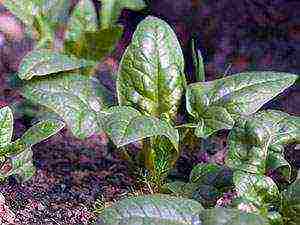
Qualitative characteristics of vegetable crops
Spinach has excellent gardening benefits, including:
- The plant is not afraid of cold weather. Seeds begin to germinate at a temperature of 4 degrees, the emerging seedlings are able to withstand short-term spring frosts.
- Early maturity and high productivity. The growing season of the plant lasts 1 month. You can plant it in your summer cottage several times every 2 weeks during the season. But the best time to harvest is spring. Leaves are more juicy and fleshy in spring.
Varietal diversity of culture
Before you start growing spinach from seed, you need to choose the right plant variety.
When choosing a variety, pay attention to the ripening time of the crop, which is indicated on the label of the seed bag. Having picked up seeds of different types, you can organize a conveyor collection on your site.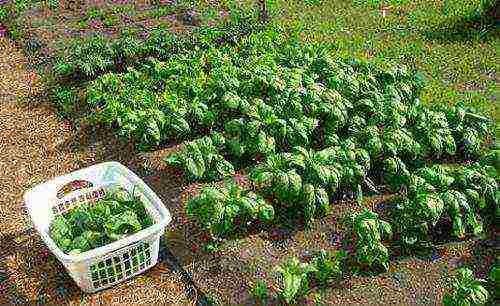 All varieties and hybrids are divided into early, medium and late ripening.
All varieties and hybrids are divided into early, medium and late ripening.
- Early varieties. After 15 days after germination, you can already cut the leaves. If sowed late, the crop will start shooting early. The early maturing ones include Matador, Gigantic, Round dance.
Please note that each of them has additional qualities:- Matador is resistant to low temperatures and flowers. By the way, this is one of the highest-yielding and popular varieties. You can learn more about it on the Internet, as well as order seeds. You will need to enter into the search "Matador spinach growing from seeds"
- Giant can be grown both outdoors and protected. Does not throw out arrows for a long time, is resistant to the accumulation of nitrates.
- The round dance has a high content of vitamins.
- Medium varieties such as Rembrandt, Emerald F1, ripen 20 days after germination.
- Late ripening. Ready to clean in 25 days. Victoria, Varyag, Ladya. They are resistant to shooting and can be sown in summer.
- For growing at home on a windowsill, take late-ripening varieties such as Victoria, Virtuoso or Melody, Prima hybrids.
It should be added that the constant breeding work on the development of new varieties of spinach, low-shooting early, resistant to powdery mildew, giving a large mass of greenery, does not stop. New items appear every year. Undoubtedly, the early ripening variety of strawberry spinach and its cultivation from seeds will arouse the interest of summer residents. It gives, in addition to juicy leaves, fruits that have a strawberry aroma. The fruits are suitable for both food and processing.
Undoubtedly, the early ripening variety of strawberry spinach and its cultivation from seeds will arouse the interest of summer residents. It gives, in addition to juicy leaves, fruits that have a strawberry aroma. The fruits are suitable for both food and processing.
Strawberry spinach is an annual plant up to 50 cm high. Fruit ovaries appear in the axils of the plant. On the fourth day after the formation of the ovaries, the fruits ripen and are ready to eat. Moreover, growing strawberry spinach is not particularly difficult.
Choosing a landing site
High-quality growing of spinach in the open field largely depends on choosing the right place for planting the crop.Consider the recommendations of the experts:
- Loamy and sandy loam soils are best suited. If you have clay, heavy soils, you should think carefully before planting a crop: you will have to spend a lot of time and effort on planting and care, and the result will be unsatisfactory. The acidity of the soil should be neutral.
- Greenery grows well in well-lit, open and elevated areas. In regions with too hot summers, you can choose partial shade for planting.
- It is advisable to plant the plant in places protected from the cold north or east wind, since the culture does not like drafts.
- Consider the rules of crop rotation when choosing a site: potatoes, radishes, legumes, cucumbers, zucchini, and tomatoes are considered the best predecessors of spinach.
- You should not plant a crop for more than 3 years in one place.
- Flowers will be bad neighbors to the plant, green crops will be good neighbors.
Features of soil preparation for sowing greenery
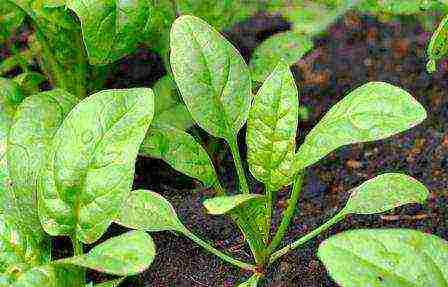 Spinach loves loose and nutritious soils, saturated with organic and mineral fertilizers, moisture and air permeable, well drained. You should start preparing a garden bed in the fall. Follow this sequence:
Spinach loves loose and nutritious soils, saturated with organic and mineral fertilizers, moisture and air permeable, well drained. You should start preparing a garden bed in the fall. Follow this sequence:
- Dig up the targeted area.
- Add organic matter (up to 8 kilograms per square meter), complex mineral fertilizer or superphosphate according to the instructions.
- Add urea before the snow melts.
- Cultivate the land in early spring.
- Add a bucket of humus per square meter of soil (if it didn't work out in the fall) and a glass of ash.
Please note that nitrates in plant leaves accumulate quickly, therefore, it is not recommended to use nitrogen fertilizers in spring and, in general, nitrogen fertilizers should be applied carefully.
Cultivation methods
You can sow spinach seeds both in open ground and in seedlings in greenhouses.
The method of growing through seedlings is not very popular. The roots of the seedlings of green culture are weak, when transplanted to the garden they are injured, they do not take root well. It is best applied to thermophilic spinach varieties (Matador, New Zealand).
Preliminary preparation of seeds
Spinach seeds have a dense shell. If you plant them dry, then the seedlings will have to wait for a long time.
To accelerate the emergence of seedlings, as well as to disinfect the seed, it is necessary to perform a set of measures:
- Sort out the material, reject small, dry nuts.
- During the day, they should be soaked in water at room temperature, changing it from time to time.
- Then, if necessary (if the material is your own, and was not purchased in a specialized store), the seeds are disinfected in a 1% solution of potassium permanganate.
- Dry slightly seed material, prepare for planting.
 Some plant varieties (Victoria, Korenta) have very poor germination, the soaking time for them is extended to two days, and biostimulants are added to the water.
Some plant varieties (Victoria, Korenta) have very poor germination, the soaking time for them is extended to two days, and biostimulants are added to the water.
How to sow a crop correctly?
You can sow spinach in open ground in August, early spring, in April, before winter. At a temperature of 5 degrees, planting can begin. When sowing, follow the instructions:
- Make tape-type grooves in 2-5 stitches. The distance between the lines is 20 cm, the row spacing is 40-50 cm. The depth of planting seeds on loamy soils is 2-2.5 cm, sandy loamy - up to 4 cm. Between the seeds in a row 5-8 cm. Expect to sow 3 g per 1 square meter of the site seeds.
- Squeeze the crops lightly, pour water over them.
- It is advisable to cover the bed with a film to protect against possible night frosts and to accelerate the emergence of shoots.
- A week and a half after sowing, shoots will appear.
The specifics of growing greenery in a greenhouse and at home
Spinach can also be grown in protected conditions - on a balcony, in a loggia, on a windowsill, in a greenhouse.
Growing spinach in a greenhouse can be started in autumn and continued until summer by sowing seeds several times. Pay attention to the details:
- In practice, greens are grown as a compactor in the aisles of vegetable crops (cucumbers, tomatoes, peppers).
- In protected ground (in a greenhouse), the lines on the beds are made every 10 cm, while the seeds, respectively, are consumed twice as much per square meter - 6g.
For home planting, you can take an ordinary flower pot (at least 1 liter of volume) or a plastic container. Be sure to make holes in the bottom to drain excess moisture and breathe roots, put drainage.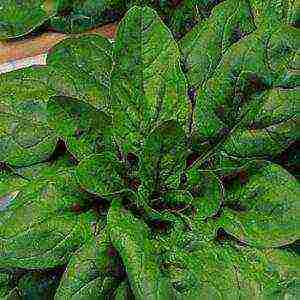 The containers are filled with prepared earth by 10-15 cm.
The containers are filled with prepared earth by 10-15 cm.
The composition of the soil mixture:
- Humus-2 parts;
- Sod land - 2 parts;
- River clean and sifted sand - 1 part.
Another soil option is possible:
- Biohumus - 1 part;
- Coconut fiber - 2 parts.
Sowing is carried out starting from the third decade of January (due to lighting).
After sowing, in a month you will be able to harvest the first crop.
Growing and caring for spinach in the greenhouse and at home is the same as outdoors.
It is important to create an appropriate temperature of 15-18 degrees and sufficient lighting. The quality of the planted spinach deteriorates at temperatures above 20 degrees: arrowing begins, flowering, the leaves become rough. 
Green crop care technology
Seedling care consists of watering, mulching, weeding, loosening, thinning, and protecting from pests.
- Plants love watering. Only with good watering will you get fleshy, large leaves. In the absence of rain, it is necessary to water using a bucket of water per square meter.
In dry, hot weather, it is recommended to water up to 3 times a week. - Growing and caring for spinach in the open field or in a greenhouse does not allow waterlogging: the culture can be affected by root rot.
- Mulching is done with grass, straw to retain moisture in the soil.
- Weeding is carried out for the first time after the first true leaf has grown. The beds should be freed from weeds regularly, not only in order to improve the vital activity of the plant, but also to protect against caterpillars and aphids.
- Loosening is performed fine, to remove the crust and access oxygen to the roots.
- Thinning is carried out simultaneously with the first weeding - in the phase of the appearance of the first leaf. A distance of 10 cm is left between individual shoots. With a denser planting, there is a risk of root rot or powdery mildew.
- Disease control. The most common greenery disease is root rot. If found, the diseased plant should be pulled out by the root, and the planting should be treated with 1% Bordeaux mixture. From pests, crops are treated with tobacco dust infusion or ready-made biological products.
Harvesting vegetable plant
It is recommended to harvest the spinach in the morning, before preparing meals. Large leaves are harvested from young plants that do not have peduncles. Pay attention to the specifics of the collection: 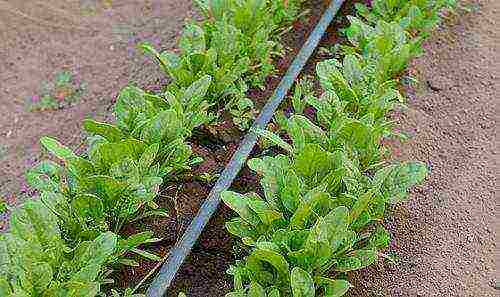
- The leaves are broken off one at a time.
- The rosettes are cut under the first leaf so that less dirt gets on the greens, and so that the further planted plant can continue to grow.
- Cutting is carried out when the leaves reach a length of 18 cm.
- The number of leaves on a ripe and ready-to-cut plant should be at least 6.
- Harvesting in the garden should be done regularly as the spinach overripe quickly.
- When the arrows of the peduncles begin to appear, the plant is removed from the garden.
- The seeds of the plant ripen in 3 months. In the ripening phase, it is necessary to cut off the brown inflorescences, put in a shaded place for ripening.
- Seed germination, which is properly stored in a dry and cool place, lasts 4 years.
For your information, seeds are collected only if one variety grows on the site, since spinach is a wind-pollinated crop. It is enough to leave 2 female plants in the beds with a distance of 20 cm between them to get a good seed yield.
A low-calorie, vitamin-rich product like spinach is ideal for a diet.Eating spinach improves immunity, relieves fatigue, it is recommended for diabetes, childhood rickets (high vitamin D content).
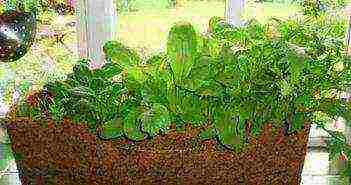
Spinach belongs to those crops that are especially popular among gardeners today. And the reason for such a demand is that the plant belongs to vitamin greens. Its leaves are actively used in cooking. It can be stored both fresh and frozen.
In addition, spinach leaves perfectly retain their taste even in hot dishes. It is the possibility of long-term storage and the simplicity of growing spinach that allowed it to become widespread among gardeners. Among the wide selection of varieties, spinach matador is most often used today.
Description of the variety
The appearance of matador spinach leaves is very similar to sorrel, but there is still a difference between these plants. Spinach has rounded foliage and rich color. But its taste in comparison with sorrel is delicate and piquant.

Spinach matador
Matador is a spinach variety that is an annual crop. It belongs to the haze family and is a relative of the beet. This is a mid-early variety that has a universal purpose. It is resistant to flowers and cold. It has thick, glossy and oval leaves. But how is growing from strawberry spinach seeds, you can find out from this article.
The rosette is half-raised, has a compact size and a length of 18-22 cm. The leaves contain components such as proteins, potassium, vitamins and carotene.
How to grow in the garden
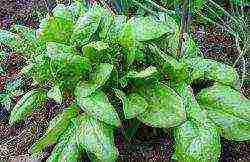
For the full growth of spinach, it is necessary to plant it on soil carefully fertilized with organic matter. Moreover, it is best that it be loamy soil. When choosing a location, it is also necessary to take into account such a factor as the acidity of the earth. The optimal variant is considered to be with a pH of 6.7-7.0. It is necessary to prepare a place for culture in the fall. To do this, dig up the selected bed, add mineral fertilizing and, if necessary, add lime.
You can sow planting material at the end of March and even in the fall to get an early harvest in the spring. Do not forget that matador is an early cold-resistant variety, so it can withstand winter frosts.
If you plant spinach in the fall, then you can harvest from these bushes 2 times. But after that, all the bushes will have to be removed.
It is possible to increase the germination rate provided that the planting material is carefully prepared. It is to be sent to warm water for 2 days. Then remove and dry the seeds. Make grooves on the prepared bed. Place them at a distance of 25-30 cm. Place the seed at a distance of 6-8 cm. Deepen each seed to a level of 2-3 cm. Now the grooves can be covered with soil, rake and irrigate. It will also be interesting to learn how to plant spinach outdoors.
It will be possible to observe the first shoots in 14 days. To get a good and tasty harvest, you need to follow some rules for caring for the crop:
- As soon as 2-3 leaves have formed, you have to perform a pick... There should be a distance between the plants at which its adjacent leaves will not touch.
- The plant should be watered 2-3 times a week. 1 bucket of water will go per 1 m2. Do not allow the topsoil to dry out.
- As soon as the arrows are formed, they must be cut off immediately. Otherwise, a high yield cannot be expected.
- Loosen the soil regularly to avoid weeds. You can understand how the fight against weeds in the garden takes place by clicking on the link.
The video shows how to sow spinach:
How to grow on the balcony
You can get juicy and fresh greens by growing spinach on the balcony. Thus, even in winter you will be able to cook your favorite dishes with spinach and saturate your body with useful components.At the same time, make sure that the temperature regime of 15-18 degrees is observed on your balcony.
This video will help you understand how asparagus is planted in open ground.
But how to plant Brussels sprouts with seeds, this article will help you understand.
What terms and procedure for planting cauliflower are detailed here:
It will also be interesting to know when to plant broccoli for seedlings.
For the full growth of the culture, a daylight period of 10 hours is required. So in winter you will have to use artificial lighting. Prepare containers in advance, lay a drainage layer there. Its thickness is 2-3 cm. After that, loose nutrient soil, which is thoroughly watered. Soak the planting material in water for a day. Lay dry seeds on top of the soil, and then sprinkle it with earth, sending it to a depth of 2 cm. Anyone who wants to know more about how spinach is grown on a windowsill should follow the link.
The video shows how to grow spinach on the balcony:
After a month, you can cut juicy greens for food. In order to maintain an optimal level of humidity, in addition to watering, irrigation of the leafy part of the plant will have to be carried out. Harvesting can take place for 2-3 months, until the flower stalks are formed. Then you will have to plant new plants. Thus, you can get fresh matador spinach all year round.
But how the planting and leaving of strawberry spinach occurs can be found in this video.
Reviews
- Marina, 32 years old: “I really love spinach. It is not only tasty, but also healthy. Since I live in an apartment, I have no opportunity to grow a culture. But once, having been on a visit, I saw that matador spinach can be grown even in indoor conditions. I also decided to take up this business. I bought containers, laid drainage, soil and seeds. Within two weeks I had green leaves on my balcony. Taking care of this plant is no more difficult than taking care of flowers. I use a stick to loosen the soil and water it regularly. Thus, I always have fresh greens in my house, no matter what the weather is outside the window. "
- Svetlana, 41 years old: “I have been growing spinach for several years now. I have a small summer cottage. The vegetable garden there is not particularly fertilized, and even small in size. But then I could grow my favorite greens there. I chose the matador variety for planting. I really like him, as he is not afraid of cold and other bad weather conditions. I plant it in early spring and after 3 weeks I can delight my loved ones with fresh greens. And all this is achieved with minimal maintenance. And what surprised me more was the high yield even on unfertilized soil. "
- Elizabeth, 26 years old: “I really love spinach, as I am on a diet and use it in cooking and salads. I grow it right on the balcony. I took an ordinary box, put the stones so that the water does not stagnate, then the ground. I bought it in the store, and only then planted the seeds. On the 13th day, sprouts appeared. Then I watered them and loosened the soil. But in winter you have to turn on the light bulbs to extend the daylight hours. Observing these simple rules, I can feast on fresh herbs throughout the year. "
Spinach matador is a unique variety that allows you to get a good harvest even with minimal maintenance. Since the matador belongs to cold-resistant crops, it can be planted outdoors even in autumn. But the uniqueness of the variety is not only in this, but in the fact that the leaves of the plant contain many vitamins and useful components that the body needs so much for full work.
Even on tiny plots, gardeners manage to harmoniously place all kinds of vegetables, herbs, berry bushes. Every year the assortment is replenished with new varieties, and some of them are not quite suitable for growing without a greenhouse.Growing spinach in the open field has just begun to be practiced, and it quickly gained popularity among gardeners, because despite fears, the plant feels great and with proper care, spinach quickly builds up a fleshy green mass.
Growing spinach in the garden: basic requirements
Spinach is an amazing plant, in some countries it is considered a weed and is ruthlessly destroyed, in others it is carefully looked after, trying to preserve every leaf. The homeland of the green vegetable is the Middle East, where it freely lives in warmth and comfort. In cooler latitudes, some effort will have to be made to provide the plant with the necessary conditions.
What does a green plant need to please with a harvest of delicious leaves?
There are very few requirements:
- regular generous watering;
- bright sunny area;
- timely removal of weeds;
- introduction of nutrients;
- light fertile soil.
If you do everything in a timely manner and avoid annoying mistakes, the handsome spinach will certainly become one of your favorite plants.
When to start planting spinach and how to do it right?
Unlike most vegetable crops, which are planted in spring or before winter, spinach can be planted throughout the year (excluding winter). In the fall, it is recommended to send a plant to the garden bed only in regions with a temperate climate, and you will definitely need a cover.
It is better to give preference to a spring planting - green leaves will be on the kitchen table throughout the warm season.
Summer planting has its own characteristics: abundant watering before planting and covering the beds with mats to accelerate the emergence of sprouts.
Sowing should be carried out in shallow grooves (up to 3 cm deep). Do not leave the row spacings wide, 30-35 cm is quite enough. The final stage of sowing should be rolling - this will keep the moisture necessary for the emergence of friendly shoots.
Features of growing strawberry spinach
Strawberry spinach arouses curiosity among many gardeners, because this curiosity has recently become popular among lovers of exoticism in the beds. As in ordinary spinach, only the leaves are valuable here (they manage to grow more than half a meter in length), while berries, despite the abundance of nutrients, are not particularly popular - they are completely tasteless.
The plant is completely undemanding to the soil, it can be grown even on loams or sandstones, although the yield will be slightly worse than on chernozems. Planting is usually done in the spring, but seeds sent in the fall are capable of giving small rosettes before persistent cold weather. Before winter, they will get stronger, and a thin cover is enough so that with the arrival of spring the plant starts to grow and already at the beginning of summer pleases with juicy large leaves.
Agrotechnics of strawberry exotic plants differ little from caring for ordinary spinach. Watering and weeding are required, and the introduction of nutrients will not be superfluous. The only difference is that you have to tie up the bushes, otherwise, under the weight of the berries, they will lie on the garden bed.
Spinach care: from planting to harvest
How does planting spinach begin? When growing any vegetable crop, it is important to choose the right variety, and green exotic is no exception. Gardeners already have their favorite spinach varieties, time-tested and delighting with an abundant harvest of juicy leaves.
You can safely grow the following varieties in the garden:
- Matador;
- Victoria;
- Fatty;
- Godry;
- Virofle.
Each of these varieties thrives both in the greenhouse and outdoors.
How to properly prepare the soil for sowing
Despite the undemanding spinach, it is impossible to grow a good harvest of leaves without top dressing, but experienced gardeners who have made friends with the plant advise to make their life easier by introducing nutrients before planting. It is better to prepare the garden 2-4 weeks before sowing the seeds.
It is enough to add 4-6 kg of good humus per square meter of the garden. The plant does not really respect fresh organic matter - the leaves will grow large, but they will lose their fleshiness. If the soil is very poor, you can also add a good handful of potash and phosphorus fertilizers before digging.
Spinach tends to accumulate nitrates, so it is better not to use nitrogen fertilizers.
Fertilizing and watering - how to avoid mistakes
Spinach loves moisture, but in hot summer it can please with fleshy leaves. If the weather does not indulge in rains, several times a month you will have to arm yourself with a watering can and pamper your plants with abundant watering. Water must first stand in the sun - cold moisture can cause disease and destroy the entire garden.
Usually, spinach has enough useful elements that were introduced into the soil during the preparation of the beds. If the plant grows slowly and is reluctant to grow green mass, you can feed it with urea. It is easy to prepare a nutrient solution - dissolve 15-20 grams in a bucket of water. urea and water the garden (first thoroughly moisten the ground). It is better not to add phosphorus and potassium during the growth period - the plant will quickly throw out the arrows.
When can you collect leaves
It is important not to miss the collection of leaves - if you are late, they will lose their juiciness, coarse, become tasteless. It is better to go to the garden for the harvest in the morning, but only in dry weather - excess moisture in the soil causes fragility and fragility of the leaves.
You can start harvesting only after the spinach has grown at least six beautiful large leaves (usually 9-11 weeks after planting). You can cut off the entire outlet or pull it out of the ground along with the root, but most gardeners prefer to constantly have fresh leaves on the table, collecting them as they grow up.
Tips to know when growing spinach from seeds
Do not assume that it is enough to send seeds to the ground to wait for an excellent spinach harvest. There are several secrets to getting succulent large leaves.
The first thing to remember is that two sprouts grow from a round seed, which grow quickly, one of them should be removed. Thinning after the appearance of the second leaf will help you get a healthy plant that does not have to share nutrients and moisture with a neighbor. The ideal distance between plants is at least 15 cm. Before thinning, the soil should be watered generously - spinach roots are very fragile and easily damaged.
Growing spinach from seeds also includes frequent loosening, especially until the plant has thrown up to 5 leaves. Simultaneously with loosening, weeding is carried out - malicious weeds can drown out fragile sprouts.
What plants in the neighborhood will spinach get along well with
Spinach lovers usually set aside large beds for their exotic handsome man, especially if the size of the garden allows. Owners of tiny plots of land should not be upset - spinach perfectly coexists with any vegetable crops, you can plant it even between rows of onions or carrots. Spinach should be grown with caution near cucumbers or zucchini - long lashes can break fragile leaves.
Spinach can even be grown in the garden by preparing a small bed. The shade from large trees is not an obstacle for the plant, but the planting should be placed so that at least a few hours a day the sun's rays penetrate the leaves. Otherwise, the harvest will be rather poor.
Which pests and what diseases can threaten spinach
Spinach has a lot of enemies, and if the gardener does not respond to the threat in time, it can completely lose the crop. The main enemy is the ubiquitous aphid. It is not recommended to deal with it with chemicals, since many harmful substances can remain in the fleshy leaves.
It is better to resort to folk methods:
- Ash broth (300 gr.pour 6 liters of boiling water over wood ash, leave for 2 hours, process the plants abundantly).
- Wormwood infusion (grind 400 g of wormwood leaves, pour 5 liters of water, stand for a day, spray).
- Soap solution (dissolve 2 bars of laundry soap in 5 liters of water, spray the plants).
Snails also do not mind, enjoy delicious leaves, in a few days with a large accumulation of the pest, you can lose the entire crop. Simple traps will help here, which you can make yourself. To do this, take plastic bottles, cut off the bottom, and bury them in the beds with spinach, making sure that the edges of the trap do not rise above the surface of the ground. It remains to pour some beer into the trap in the evening, which will certainly attract pests. In the morning, you can harvest snails that could not get out of the plastic cup after the feast.
Of the diseases, powdery mildew can threaten spinach. You need to deal with it even when planting a plant - it is important to place the bushes at the required distance. A dense planting is the main cause of the onset of the disease. With a small infection, you can try to spray the spinach with whey or infusion of garlic (insist 100 grams of garlic in 3 liters of water for 2 days).
Root rot can also kill spinach. Measures that will help to avoid the disease are timely loosening of the soil, thinning of plantations. The use of chemicals is not recommended - if the disease cannot be avoided, the plant can no longer be saved.
